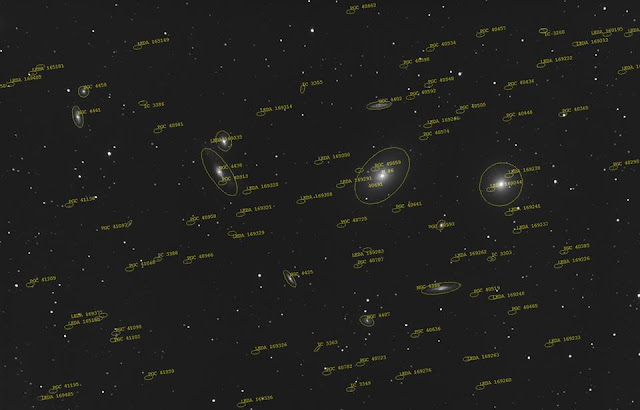
The sixth constellation of the Zodiac is the one we know as Virgo The Virgin. It is a very ancient constellation. Not only was it known to Paleolithic Man, it was carved --- not merely painted --- onto cave walls, suggesting that Virgo was more than just a constellation or even an average deity.
Both the asterism and the cave carvings of 30,000 years ago suggest a recumbent woman with an arm placed behind her head, a frankly sexual pose which is well at odds with the concept of "The Virgin." Early humans no doubt made the connection between the length of the menstrual cycle and the lunar month, and the fact that the average pregnancy lasts ten lunar months. All these correspondences would have reinforced Virgo's central status in humankind's thinking. Early human societies were matriarchal, and so Virgo (by whatever name she may have been known) was quite possibly the chief sign in the sky. In terms of size, Virgo is the second largest constellation in our skies (after Hydra The Water Snake), and depending on how early man perceived Hydra, Virgo may have been the largest, certainly bigger than Orion the corresponding figure of a male.
 |
| The earliest representation of Virgo, carved on a cave wall 30,000 years ago in today's France. |
The Vestal Virgins' mark of office was a bent wand. Called a "Verge," when they rapped it on the ground their judgement was final. To challenge them --- "to be on the verge" --- could be fatal to someone. Later, "Verge" became the word for a measure of land or a boundary, or the title of an Church office whose officials ("Vergers") carried staffs as a symbol of their power.
Another word for "verge" was "talea" or "measure" from which words like "curtail" and "entail" and "detail" and "tally" ("tale") are derived (not to seem vulgar, but this may also be the root of the expression "getting some tail" from a woman).
The etymological root of the word "virgo" translates as "self-sufficient." In every early culture Virgo was "The Great Goddess." It was she who lent her power to such mythological figures as Isis in Egypt, Ishtar in Babylonia, Ceres the Roman goddess of grain and wheat, the Greek goddesses of justice Dyke and Astrea, and the Roman goddesses of justice, Erigone and Themis. Virgo's role as the goddess of justice makes more sense when one realizes that in ancient times Libra The Scales was not a separate constellation. As late as 1000 C.E. star guides showed Virgo as Themis, holding the Scales high.
 |
| Virgo as Themis or Astrea, holding both a sheaf of corn and Libra The Scales. A modern interpretation. |
As Astrea, Virgo was, significantly, the last goddess to quit Earth and move to Olympus, obviously resistant to leaving her earthbound charges. Virgo was also the goddess Arista, the guardian of harvested grain. She may also be seen as the self-reliant warrior goddess Athena, armed with a sword or spear.
The most common tale of Virgo is the Greek myth of Demeter and Persephone. Demeter was the goddess of the grain harvest, while Persephone, the goddess of Spring, was her daughter. Persephone was kidnapped and raped by Hades the god of the underworld, who refused to release her. Enraged, Demeter ruined the Earth's harvests. Concerned for both gods and men, Zeus ordered Hades to allow Persephone to be with her mother for part of the year. The harvest season, which is the season of Virgo, marked the last days of Persephone's annual visit with her mother. The Greeks believed that Demeter rose to the sky as the constellation Virgo, brandishing a sheaf of wheat as she watched and waited for her daughter to return. Thus, Virgo has always represented life-giving, and the life-giving force of the harvest. Virgo, far from being sexless, has represented fecundity since before the dawn of time.
 |
| The Virgo asterism showing Spica and the other main stars. The name "Vindemiatrix" means "Woman Who Harvests Grapes". |
Today the Sun is in Virgo for an impressive six week span, from the 16th of September to the 30th of October, still the late harvest season, though in the old days Virgo was the August-September constellation. The First Point of Libra, the Autumn Equinox, currently occurs in Virgo.
Virgo's brightest star is Spica "The Spike" (Number 33 in the Nautical Almanac --- see my post on Spica). Virgo is rich in stars with exoplanets: 29 of its stars host a total of 35 known planets. One of these, discovered in 1994, was the first known exoplanet. There are an array of Deep Sky Objects in Virgo, including the Virgo Cluster consisting of more than 2000 galaxies, which forms the heart of the Virgo Supercluster to which the Milky Way itself belongs.


No comments:
Post a Comment